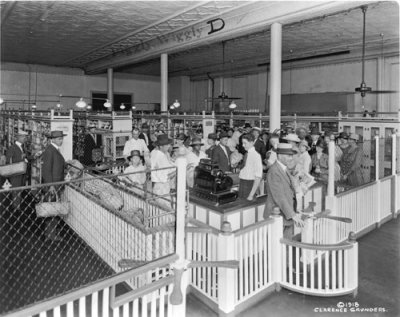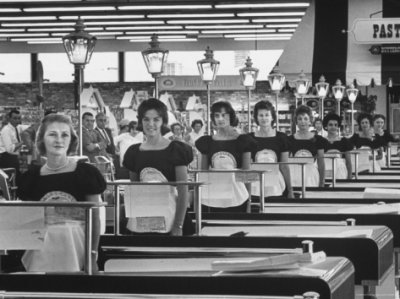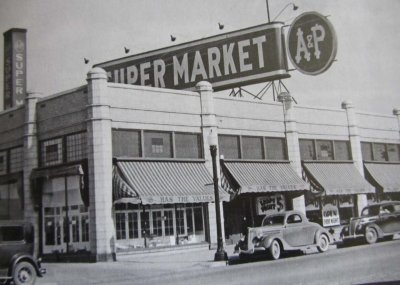Want to buy or sell something? Check the classifieds
-
The Fedora Lounge is supported in part by commission earning affiliate links sitewide. Please support us by using them. You may learn more here.
You are using an out of date browser. It may not display this or other websites correctly.
You should upgrade or use an alternative browser.
You should upgrade or use an alternative browser.
Vintage grocery stores
- Thread starter Broccoli
- Start date
GHT
I'll Lock Up
- Messages
- 9,895
- Location
- New Forest
The competition that is the major supermarkets has driven the old style counter store almost to extinction. The problem is the high cost of property, whether you rent or buy. I do know what you mean when you say: "Did they ever look good?" Google Sainsburys. then trace them back to the days of counter service.
If you ever find yourself in London, one of the best shopping experiences are the street markets. We have lots of them. Ranging from the very touristy, yet sumptuous Leadenhall Market, to a whole range of famous and less famous Street Markets. London's barrow boys, as the stall holders are called, will keep up a sales patter that will have you in stitches. You'll love the cockney accent; 'Ere ya go darlin' them's laverlee binarnas: Two pahnd for a pahnd!
But beware the shysters.
If you ever find yourself in London, one of the best shopping experiences are the street markets. We have lots of them. Ranging from the very touristy, yet sumptuous Leadenhall Market, to a whole range of famous and less famous Street Markets. London's barrow boys, as the stall holders are called, will keep up a sales patter that will have you in stitches. You'll love the cockney accent; 'Ere ya go darlin' them's laverlee binarnas: Two pahnd for a pahnd!
But beware the shysters.
SSuperDave
New in Town
- Messages
- 39
- Location
- Houston TX
"White Heat" and "Double Indemnity" both have scenes in a grocery store of the times.
- Messages
- 12,736
- Location
- Northern California
The Harvest Market at Mendosa's in Mendocino, California is a nice little market in a neat little town by the ocean. It is the same town where parts of Murder She Wrote and a few other movies (parts of East of Eden) were filmed.

Last edited:
Matt Crunk
One Too Many
- Messages
- 1,029
- Location
- Muscle Shoals, Alabama
We have a small place called Staggs Grocery that has remained pretty much unchanged since the 50s or 60s. They still have a lunch counter that serves up a legendary local burger that remains unchanged as well.
The photo on the right shows the front part of the store. The groceries are in the back.


The photo on the right shows the front part of the store. The groceries are in the back.


- Messages
- 13,474
- Location
- Orange County, CA
In Garden Grove, not far from Disneyland, is a place called Zlaket's Market which had been in the same location since 1928. As you can see it looks pretty much unchanged.




- Messages
- 17,316
- Location
- New York City
I could be wrong, but I bet LizzieMaine is going to have some good insight on this topic and, perhaps, a picture or link to pictures of some classic vintage grocery stores. Living in NYC, there was an upscale market Balducci's in Greenwich Village (I'm guessing around 6th Avenue and 8th Street) that was a throwback of sorts: not so much pretty, but comforting in its vintage feel both in fixtures and the old way food was presented and packaged. Since I am not familiar with the copyright laws, I won't post them, but if you Google Balducci's West Village Store Closing, then click Images, the fourth image from the left (top row) gives you a sense of what it looked like. Balducci's moved and open several new store that I'm sure are nice, but the one that closed had that authentic vintage feel. There is also an old German grocery store (maybe more butcher / specialty food store) called Schaller and Weber on the Upper East Side (in what was once called Germantown owing to its concentration of German immigrants) that is still in existence and is great to go into to shop. If you Google Schaller and Weber and then click Images, you will see several new and old photos.
Giftmacher
One Too Many
- Messages
- 1,405
- Location
- Hohenmauth CZ
Decades unchanged stores, it's perhaps possible only in America. At least we don't have many of these 
David Conwill
Call Me a Cab
- Messages
- 2,855
- Location
- Bennington, VT 05201
I've been in a few that still resemble this 1964 shot of the "Super Giant".
David Conwill
Call Me a Cab
- Messages
- 2,855
- Location
- Bennington, VT 05201
Also, this 1952 shot of the "Grand Union" shows a nice Art Deco look.
Featured products
-
 John Lofgren Monkey Boots Shinki Horsebuttt - $1,136 The classic monkey boot silhouette in an incredibly rich Shinki russet horse leather.
John Lofgren Monkey Boots Shinki Horsebuttt - $1,136 The classic monkey boot silhouette in an incredibly rich Shinki russet horse leather. -
 Grant Stone Diesel Boot Dark Olive Chromexcel - $395 Goodyear welted, Horween Chromexcel, classic good looks.
Grant Stone Diesel Boot Dark Olive Chromexcel - $395 Goodyear welted, Horween Chromexcel, classic good looks. -
 Schott 568 Vandals Jacket - $1,250 The classic Perfecto motorcycle jacket, in a very special limited-edition Schott double rider style.
Schott 568 Vandals Jacket - $1,250 The classic Perfecto motorcycle jacket, in a very special limited-edition Schott double rider style.
David Conwill
Call Me a Cab
- Messages
- 2,855
- Location
- Bennington, VT 05201
And, of course, Shorpy has no lack of the older, counter-service type grocery from before the war, like this 1910 shot of Detroit's Neumann Grocery.
LizzieMaine
Bartender
- Messages
- 33,914
- Location
- Where The Tourists Meet The Sea
The most common grocery stores were those like the ones shown in the previous posts -- little mom-and-pop stores, and every town had many of them, at least one for every neighborhood. They sold bread, milk, canned and packaged goods, and minor household needs. They might have a small meat cooler, and might also sell a small selection of fresh vegetables, which would usually be displayed in crates set up on the sidewalk in front of the store.
The bigger "chain grocers" were downtown -- the A&P, the First National, the Red and White, or whatever other regional chain was common in your area. A&P dominated the chain grocery market -- they had over 12,000 stores in the early thirties -- and most of them looked alike. THey had a red-painted front with display windows on either side of the door and a big sign over them reading THE GREAT ATLANTIC & PACIFIC TEA CO. During the twenties most of these were clerk-service -- you stepped up to the counter, gave the clerk your list, and waited for him to collect your merchandise. By 1930, self-service was coming in, with bigger stores arranged in aisles. These were usually still in downtown locations, but might be larger, purpose-built buildings with porcelain tile on the inside walls and oiled wooden floors. The aisles were closely spaced, and while some stores offered carriages for shoppers to use, hand-held baskets were more common. You collected your purchases and moved to a check-out counter at the front of the store, similar to the way it's done today. There were no scanners, of course, but most larger stores had multiple check-out counters equipped with electric cash registers, and the clerks made few errors.

Housewife Lynne Massman shops in a Washington D. C. grocery store, December 1943.
The idea of free-standing "Super Markets" appeared in the early thirties in the New York City suburbs, and slowly spread. It wasn't until the postwar era that the idea of a "shopping plaza" caught on, leading to the giant supermarkets of today.
The bigger "chain grocers" were downtown -- the A&P, the First National, the Red and White, or whatever other regional chain was common in your area. A&P dominated the chain grocery market -- they had over 12,000 stores in the early thirties -- and most of them looked alike. THey had a red-painted front with display windows on either side of the door and a big sign over them reading THE GREAT ATLANTIC & PACIFIC TEA CO. During the twenties most of these were clerk-service -- you stepped up to the counter, gave the clerk your list, and waited for him to collect your merchandise. By 1930, self-service was coming in, with bigger stores arranged in aisles. These were usually still in downtown locations, but might be larger, purpose-built buildings with porcelain tile on the inside walls and oiled wooden floors. The aisles were closely spaced, and while some stores offered carriages for shoppers to use, hand-held baskets were more common. You collected your purchases and moved to a check-out counter at the front of the store, similar to the way it's done today. There were no scanners, of course, but most larger stores had multiple check-out counters equipped with electric cash registers, and the clerks made few errors.

Housewife Lynne Massman shops in a Washington D. C. grocery store, December 1943.
The idea of free-standing "Super Markets" appeared in the early thirties in the New York City suburbs, and slowly spread. It wasn't until the postwar era that the idea of a "shopping plaza" caught on, leading to the giant supermarkets of today.
Kahuna
One of the Regulars
- Messages
- 270
- Location
- Moscow, ID
When my grandfather on my Dad's side was gradually dying from a brain tumor, he set my grandmother up in the grocery business so she would have a steady income. The store was set up in the front room of their house, a room probably no bigger than 12'x12'. I wish I had pictures to share but the room is indelibly set in my mind: 10 foot tall walls lined with shelves of canned goods up to the ceiling. Just inside the front door 2 penny candy dispensers (I still have the coveted tiny working lighter from one of them). Back in the corner a large refrigerator held eggs, milk, and cold sodas. An L-shaped glass counter ran across the back & side of the room with penny candies in one case and lunch meats & cheeses in the other refrigerated side. Neon signs advertising soda hung in the front window. A curtain running across the back of the room separated the store from the living space. This tiny room supplied most of the immediate neighborhood with their groceries. A trip to the A&P was required for more exotic items or fresh fruits and vegetables but for most things people walked to the corner store. This room provided a living for my grandmother from 1937 well into the 70's. I sure wish someone would have had the foresight to take some pictures of the place but, for me, my memories are just as good.
LizzieMaine
Bartender
- Messages
- 33,914
- Location
- Where The Tourists Meet The Sea
That was called a "parlor grocery," and they were very common during the Depression, especially in small towns and urban neighborhoods. Parlor groceries and minature golf courses were the most popular home-based businesses during the Depression, and sometimes you'd even find them combined -- a parlor grocery in the front and a miniature golf course in the back yard.
Zoning regulations in many towns in the postwar era put an end to this sort of thing, but for a while it was a regular part of American life.
Zoning regulations in many towns in the postwar era put an end to this sort of thing, but for a while it was a regular part of American life.
We had one of those - I think - in our urban neighborhood just outside Detroit. I don't know if anyone lived on the premises, but it was a very small store set in the midst of several blocks of regular houses. We kids (and I think adults) referred to it as "the little store". It had the things a housewife might need at short notice such as milk and bread.
The bigger grocery stores (A&P, etc.) was where we drove to for the main food supply for the week.
It's "claim to fame" for us kids was that they had the best selection of awful candy you could want. Wax lips, candy cigarettes, licorice, and all the stuff we should not have at a price you couldn't resist. They also had quality candy like Hershey bars and three Musketeers for kids with some good taste.
Since it was the height of the baby-boom time they also had stuff like kites and string for sale, in season. (Ten cents for an assemble-it-yourself Hi-Flier kite) A great selection of comic books, also.
They definitely knew their market/customers...
The bigger grocery stores (A&P, etc.) was where we drove to for the main food supply for the week.
It's "claim to fame" for us kids was that they had the best selection of awful candy you could want. Wax lips, candy cigarettes, licorice, and all the stuff we should not have at a price you couldn't resist. They also had quality candy like Hershey bars and three Musketeers for kids with some good taste.
Since it was the height of the baby-boom time they also had stuff like kites and string for sale, in season. (Ten cents for an assemble-it-yourself Hi-Flier kite) A great selection of comic books, also.
They definitely knew their market/customers...
HudsonHawk
I'll Lock Up
- Messages
- 4,380
LizzieMaine
Bartender
- Messages
- 33,914
- Location
- Where The Tourists Meet The Sea

Outside a typical downtown A&P, c. 1936.
David Conwill
Call Me a Cab
- Messages
- 2,855
- Location
- Bennington, VT 05201
- Messages
- 17,316
- Location
- New York City
LizzieMaine, as always, you did not disappoint. I remember my Dad telling me that miniature golf was a big craze during the depression and that people had miniature golf courses as businesses in their backyard and "on every other empty lot" (but I don't remember him mentioning anything about the parlor grocery). I'm sure others have told you this, but somehow - a book, a website, something - you should leverage your extensive knowledge of the Golden Era, both as a potential revenue venture for you and so that the information is out there for the rest of us. Beyond your factual knowledge, you understand the feel, the vogue and the nuance of the period - how people lived day to day, how things were viewed differently, what it felt like to live in that time period - that goes beyond just knowing the facts or even the details.
Hudson Hawk, great photos. I believe the person who started this thread asked if grocery stores looked any better back in the Golden Era - your photos (and some others in this thread) answer that one. There is an elegance, a daily dignity that we have lost. I just got back from a few errands, and because this thread was in my head, I noticed how many people truly do not care how they dress when in public and how tacky my local grocery store looks.
Hudson Hawk, great photos. I believe the person who started this thread asked if grocery stores looked any better back in the Golden Era - your photos (and some others in this thread) answer that one. There is an elegance, a daily dignity that we have lost. I just got back from a few errands, and because this thread was in my head, I noticed how many people truly do not care how they dress when in public and how tacky my local grocery store looks.
Similar threads
- Replies
- 3
- Views
- 504
- Replies
- 0
- Views
- 298
Members online
- Trouser Bark
- Clozer
- gmaki
- Monitor
- Fading Fast
- s4rmark
- frogbart123
- Tom71
- BaslerChrysler
- thammer
- Dingomama
- bootsonatrain
- joezam713
- twentyfiveshells
- mjay
- mj2936
- Johnny Deadlifts
- Mean Eyed Matt
- MickeyPunch
- JonS1967
- keruan
- JackBroChill
- Gringoone
- Al 916
- stmike
- TartuWolf
- jacketjunkie
- Joao Encarnado
- LeatherJack
- Jiantle
- Destruct
- Kenmar8181
- Bootsndenimnyc
- jeepTj98
- Ohmufasaa
- WolferlQ3
- herculance
- CRH
- nathlee1992
Total: 2,602 (members: 48, guests: 2,554)


